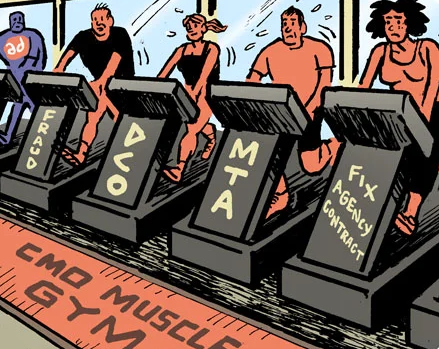In the past few weeks, some of the world’s biggest soda, snack and candy companies reported quarterly earnings, so this week we’re introducing ad tech to a new three-letter acronym – GLP-1. Even if many of these companies aren’t worried about the impacts this drug is having, 2025 is officially the year that GLP-1 solidifies itself as a force in the advertising world.
GLP-1, btw, is the hormone Glucagon-like Peptide-1, better known for pharmaceuticals like Ozempic and Wegovy that reduce food cravings.
Unaffected
“We continue to study GLP, obviously,” PepsiCo CEO Ramon Laguarta told an investor who’d asked about the impact on its salty snacks. “At this point, because of the lower levels of adoption and people coming in and out of the treatment, we see very little impact in our business and in our category.”
Hershey’s got the same question, too. “We are seeing no material impacts,” said CEO Michele Buck.
Mondelez CEO Dirk Van De Put likewise said his candy and snack company has seen “no effect that we can tell.”
Coca-Cola CEO James Quincey even alluded to a potential silver lining: “So far, our take is [GLP-1 drugs] aren’t a big aggregate factor for the beverage industry – or the non-alcoholic beverage industry,” he said.
It isn’t soda, therefore, that’s under pressure, so much as beer and booze.
The health shake-up
Snack and candy companies are quick to assuage the concerns of investors. And the anecdotal evidence of diminished snacking may be exaggerated.
But even as CEOs claim that weight loss drugs haven’t affected their business, their businesses are in a state of massive overhaul. They are reinventing their product lines and marketing strategies for a world in which appetite depressants are easily available and consumers snack less often.
People are looking for “functionality” from their snacks nowadays, said Laguarta, which he specifies as snacks with protein or that are baked rather than fried and have whole grains or legumes rather than grains or corn products.
Pepsi’s Frito snack line, for example, is struggling. But SunChips, which are baked and now offered in grain-free options, are on the rise. Laguarta also cited recent acquisitions of Sabra hummus and Siete, which makes grain-free tortilla chips, as new snacks that are Pepsi’s entrée to “mini-meals” that carry a few hundred calories and include protein.
Snack keywords like “protein” and “low sodium” are crucial for the new world of snacking, much of it inspired by search terms, since grocery shopping is happening more online.
Wonderful, the world’s largest seller of pistachios and other nuts, has a marketing campaign called “Ditch the Chips,” which takes advantage of this exact dynamic. In a grocery store, its pistachio bins are often in the fruit and produce section, alongside bananas and other healthy snacks. But online, pistachios can leap over the metaphorical shelves to target searches for chips and other salty snacks with a healthier alternative.
For an anecdotal example, check out the General Mills line of Cheerios with protein, which launched in December. The word “Protein” is bigger and bolder than the word “Cheerios,” and makes other keywords on the box, such as “cinnamon” and “gluten-free,” look like fine print.
Back to advertising
The trend of healthier snacking and weight-loss drugs does come directly back to ad budgets and can be as dangerous as taking your eye off a boomerang.
The main purveyors of salty or sugary food and drinks are having their margins compressed by these trends.
There are other actual misfortunes. A poor harvest in northwest Africa, where a majority of the world’s cocoa beans are grown, has contributed to the price of cocoa beans quadrupling in the past two years alone.
And you thought your inflation was bad.
The result is that candy and cookie companies are holding a tough line on price.
“We need to protect key price points and thresholds, so that consumers can continue to enjoy their chocolate,” said Van De Put, whose Mondelez brands include Oreo and Chips Ahoy!
But price and advertising are flip sides of the same coin. If there is no wiggle room to discount products, the ad budget is limited, too.
Mondelez CFO Luca Zaramella says the company has reduced nonworking media spend – cutting out data, vendors or other costs as it tries to maintain advertising reach while spending fewer dollars.
“On the marketing spending, there is an element of phasing,” said Nestle CEO Laurent Freixe about the company’s flattish ad spend. “We need to get the value equation right.”
Nestle’s profit margin is shrinking as the costs of goods and ingredients increase faster than its sales. With profit margins already decreasing, the company can’t just crank up advertising.
Nestle is reworking its packaging and assortment to have “the right price architecture,” Freixe said. Once it does, “then we can go full blast with our communication efforts.”
Quincey touted the marketing budget as an avenue for increasing Coca-Cola’s profit margin this year. But that’s because the company is spending less total on advertising.
In Q4, Coca-Cola used generative AI for the first time to help produce ad creative “quicker and cheaper,” he said.
“This is not less marketing,” he said. “This is more productive spend.”
But it is less marketing.
So get used to it. Unless pharma brands can also manufacture new drugs that reduce the online ad industry’s cravings for retail media budgets.














